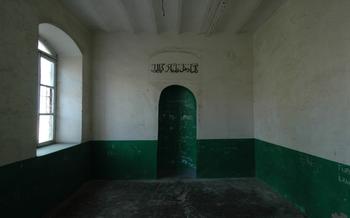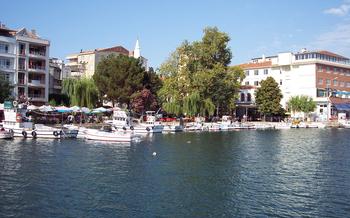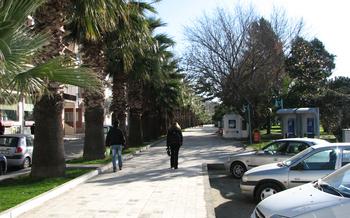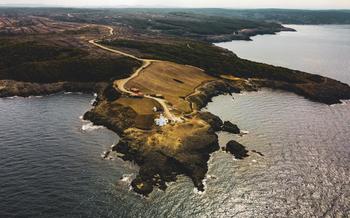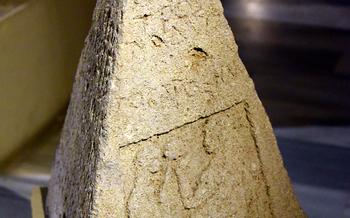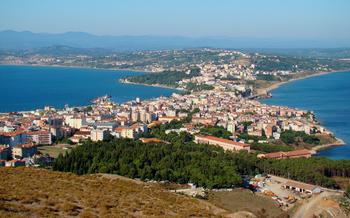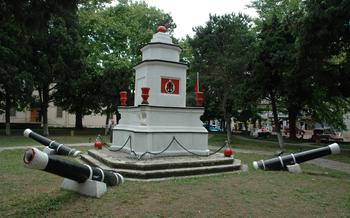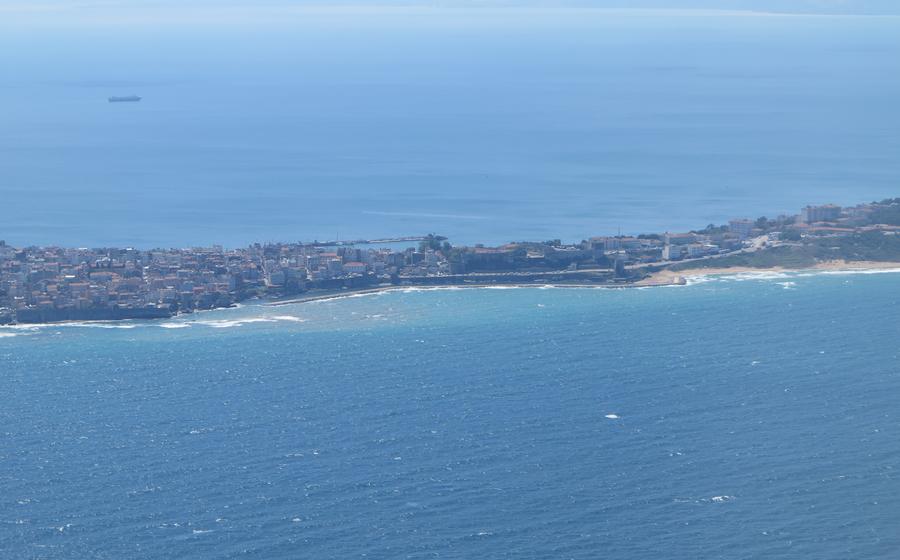
Serapeion Monument
- Historical Significance
- Architectural Marvel
- Location and Accessibility
- Excavation and Restoration
- Preserved Artifacts
- Mythology and Legends
- Guided Tours and Local Experts
- Photography Opportunities
- Combination with Other Attractions
- Visitor Tips and Etiquette
- Cultural Significance
- Local Cuisine and Dining Options
- Souvenir Shopping
- Accommodation Options:
- Insider Tip: Unveiling the Hidden Treasure
Historical Significance
Journey back in time to the ancient city of Sinop, where the Serapeion Monument stands as a testament to the city's rich history and cultural heritage. Dedicated to the Greco-Egyptian god Serapis, this remarkable monument embodies the religious tolerance that prevailed during the Roman era. Its construction marked a significant chapter in Sinop's history, bridging the gap between two great civilizations and showcasing the harmonious coexistence of diverse beliefs. Explore the monument's intriguing past and discover the stories it holds within its walls, offering a glimpse into the religious practices and cultural exchanges that shaped this ancient city.
Architectural Marvel
The Serapeion Monument stands as a testament to the architectural prowess of the Roman era. Its unique design showcases a harmonious blend of Greek and Egyptian architectural elements, reflecting the cultural fusion that characterized the region during that period. The monument's exterior features intricate carvings and reliefs depicting various deities and mythological scenes, showcasing the artistic skills of its creators. The interior, though partially ruined, reveals a spacious chamber with vaulted ceilings, supported by massive columns. These architectural elements not only add to the monument's aesthetic appeal but also demonstrate the advanced construction techniques employed by the Romans. The Serapeion Monument's architectural significance lies in its representation of cultural exchange and the enduring legacy of ancient craftsmanship.
Location and Accessibility
The Serapeion Monument stands proudly in the heart of Sinop, Turkey. Its exact location is within the ancient city walls, a mere stone's throw from the picturesque Sinop Castle. This proximity to other notable landmarks, such as the Sinop Archaeological Museum and the Balatlar Church, makes it an ideal starting point for exploring the city's rich history.
Reaching the Serapeion Monument is a breeze, thanks to its central location. Public transportation options, including buses and taxis, are readily available, making it easy to get to the site from any part of Sinop. For those who prefer a more leisurely approach, a pleasant walk through the charming streets of the old city will lead you right to the monument's doorstep.
Excavation and Restoration
The Serapeion Monument's rediscovery in the 19th century sparked a wave of archaeological interest and excavations. The initial excavations, conducted by French archaeologists, revealed the monument's impressive size and intricate carvings. However, it wasn't until the 1950s that systematic excavations were undertaken by Turkish archaeologists.
The excavation process was not without its challenges. The monument's location, partially buried underground, required careful and meticulous work to uncover its hidden treasures. Archaeologists had to navigate through layers of soil and debris, ensuring the preservation of delicate artifacts and structures.
In recent years, the Serapeion Monument has undergone extensive restoration efforts to preserve its grandeur and historical significance. These efforts have focused on stabilizing the monument's structure, repairing damaged elements, and restoring its original appearance. The ongoing restoration work aims to protect this ancient marvel for future generations to appreciate and enjoy.
Preserved Artifacts
During the meticulous excavation of the Serapeion Monument, a treasure trove of artifacts was uncovered, shedding light on the history and culture of the region. These unearthed relics offer invaluable insights into the beliefs, practices, and craftsmanship of ancient civilizations.
Among the most significant discoveries are intricately carved statues and sculptures depicting various deities and mythological figures. These exquisite artworks showcase the exceptional artistic prowess of the era, capturing the essence of divine beings with remarkable detail and precision.
Coins, pottery fragments, and jewelry unearthed at the site provide a glimpse into the daily lives of the people who once frequented the monument. These artifacts reveal intricate designs, symbols, and inscriptions, hinting at the economic activities, trade networks, and cultural influences that shaped the region.
Of particular note are the well-preserved inscriptions found within the monument. These texts, written in ancient scripts, offer invaluable historical information, shedding light on the monument's construction, religious rituals, and the diverse cultural influences that converged at this sacred site.
The discovered artifacts from the Serapeion Monument are currently housed in various museums and institutions, where they are preserved and studied by scholars and historians. These precious relics serve as tangible links to the past, allowing us to unravel the mysteries and marvel at the ingenuity of ancient civilizations.
Mythology and Legends
Beyond its historical significance, the Serapeion Monument is steeped in mythology and legends that add to its allure. The monument was closely associated with the cult of Serapis, a Greco-Egyptian deity worshipped in the region during the Hellenistic and Roman periods. According to mythology, Serapis was a combination of the Greek god Zeus and the Egyptian god Osiris. His cult aimed to bridge cultural differences and promote religious tolerance, mirroring the monument's own unique blend of architectural styles.
Legends abound about the miraculous powers of Serapis. Believers sought healing and divine intervention at the monument, leaving behind votive offerings as tokens of their gratitude. One famous legend tells the tale of a blind man who regained his sight after praying at the Serapeion. Word of this miracle spread far and wide, attracting pilgrims from across the region.
These myths and legends not only enhance the monument's historical significance but also add a touch of mystery and wonder to its aura. Visitors can't help but be captivated by the stories associated with the site, making their visit a truly immersive and unforgettable experience.
Guided Tours and Local Experts
To delve deeper into the rich history and significance of the Serapeion Monument, consider booking a guided tour led by passionate local historians or archaeologists. These experts will provide invaluable insights into the monument's construction, religious significance, and excavation process. They can also share captivating stories and anecdotes that bring the monument's past to life.
I personally had the privilege of joining a guided tour led by a renowned archaeologist who shared fascinating details about the monument's architecture, symbolism, and connection to the ancient city of Sinop. The tour enhanced my understanding and appreciation of this remarkable site, making it a truly memorable experience.
Whether you're a history buff, an architecture enthusiast, or simply curious about the Serapeion Monument, a guided tour is an excellent way to gain a deeper understanding and appreciation for this ancient treasure. Embrace the opportunity to learn from local experts and create lasting memories of your visit to Sinop.
Photography Opportunities
The Serapeion Monument is a photographer's dream, with its striking architectural features and picturesque surroundings. The monument's imposing facade, intricate carvings, and dramatic lighting conditions make it an ideal subject for capturing stunning photographs.
For the best results, visit the monument during the golden hours of dawn or dusk, when the warm, diffused light casts a magical glow on the ancient stones. Experiment with different angles to capture the monument's grandeur from various perspectives. Utilize the surrounding landscape, such as the lush greenery or the sparkling sea, to create a captivating backdrop for your shots.
Tripod usage is highly recommended to ensure sharp and steady images, especially when shooting in low-light conditions. Consider using a wide-angle lens to capture the monument's full scale and majesty. For close-up shots of intricate details, a macro lens would be a valuable asset.
Remember to be respectful of other visitors and avoid using flash photography, which can be disruptive and damaging to the monument's delicate surfaces. Embrace the opportunity to unleash your creativity and capture the essence of this ancient marvel through the lens of your camera.
Combination with Other Attractions
Complement your visit to the Serapeion Monument by exploring other captivating attractions in Sinop. Immerse yourself in history at the Sinop Archaeological Museum, housing a treasure trove of artifacts from the region's rich past. Discover the grandeur of the Sinop Fortress, an imposing structure that has stood guard over the city for centuries. Relax and unwind on the pristine Akliman Beach, just a short stroll away, where you can bask in the sun, swim in the azure waters, and soak up the breathtaking views.
To create a well-rounded itinerary, consider venturing beyond the city center. Explore the stunning beaches that dot the Sinop coastline, each with its unique charm. Discover hidden coves, marvel at the towering cliffs, and find your perfect spot to soak in the tranquility of the Black Sea. Embrace the natural wonders of the region by venturing into its lush forests, home to diverse flora and fauna.
Sinop offers a harmonious blend of history, nature, and local culture. Whether you seek adventure, relaxation, or cultural immersion, this vibrant city has something to offer every traveler. Craft your own unique itinerary, combining the Serapeion Monument with other attractions, to create an unforgettable and enriching experience in Sinop.
Visitor Tips and Etiquette
When visiting the Serapeion Monument, it is essential to be mindful of the historical significance of the site and to act respectfully. Appropriate attire is recommended, considering the monument's religious and cultural importance. Visitors should be prepared for the weather conditions, as Sinop can experience both hot summers and cold winters. Safety precautions should always be taken, especially when exploring the monument's surroundings. It is important to stay on designated paths and avoid climbing on or damaging any part of the structure. By respecting the site's integrity and following local customs and traditions, visitors can contribute to preserving this ancient treasure for generations to come.
Cultural Significance
The Serapeion Monument transcends its architectural grandeur and historical significance to embody the rich cultural exchange that flourished in the ancient world. As a symbol of religious tolerance, it stands as a testament to the harmonious coexistence of diverse beliefs and practices. This monument reflects the cultural synthesis that occurred during the Hellenistic and Roman periods, where Greek and Egyptian influences blended to create a unique religious and cultural landscape.
The Serapeion Monument's significance extends beyond its local context. Its exceptional preservation and unique features have earned it recognition as a UNESCO World Heritage Site, highlighting its global importance. This designation underscores the monument's contribution to our understanding of cultural interactions and the interconnectedness of ancient civilizations. By preserving and celebrating this site, we honor the legacy of tolerance, diversity, and cultural exchange that shaped the foundation of our modern world.
Local Cuisine and Dining Options
A visit to the Serapeion Monument can be complemented by savoring the delicious local cuisine of Sinop. The city offers a diverse range of restaurants and cafes that cater to various tastes and budgets. For an authentic Turkish dining experience, try Köşk Balık Restaurant, renowned for its fresh seafood and stunning views of the Black Sea.
Indulge in the flavors of traditional Turkish dishes such as hamsi buğulama (steamed anchovies), çöp şiş (skewered meatballs), and kuru fasulye (white bean stew). Don't miss the opportunity to sample Sinop mantısı (local ravioli) and Sinop pidesi (flatbread with various toppings), unique delicacies that reflect the city's rich culinary heritage.
To enhance your dining experience, engage with the friendly locals and ask for recommendations on hidden culinary gems. Embrace the vibrant atmosphere of the city's markets, where you can find fresh produce, spices, and Turkish delights to savor or take home as souvenirs.
Souvenir Shopping
Seeking a one-of-a-kind souvenir to commemorate your visit to the Serapeion Monument? Venture into the vibrant local markets or charming shops nestled around the monument to discover an array of unique handicrafts and trinkets. These treasures, lovingly crafted by local artisans, offer a tangible connection to the rich cultural heritage of Sinop. From intricately designed pottery and handwoven textiles to exquisite jewelry inspired by ancient motifs, there's something for every taste and budget. Engage in the lively art of bargaining, a delightful local custom, to secure the best prices and support the livelihoods of these talented craftspeople. As you browse through the colorful stalls, let your inner explorer shine, unearth hidden gems, and carry a piece of Sinop's essence back home with you.
Accommodation Options:
When planning your stay in Sinop, there are several accommodation options to choose from, catering to different preferences and budgets. For a truly immersive experience, consider staying in a traditional Turkish guesthouse or pansiyon. These cozy establishments offer a glimpse into local culture and hospitality, with warm Turkish décor and personalized service. They are often located within walking distance of the Serapeion Monument and other historical sites, allowing you to explore the city at your leisure.
For a more modern and luxurious stay, there are several reputable hotels in Sinop that offer comfortable rooms, amenities, and convenient locations. International hotel chains and local hospitality groups provide a range of options to suit your needs and budget. When choosing a hotel, consider factors such as proximity to the Serapeion Monument, amenities, and guest reviews to ensure a pleasant and memorable stay.
Insider Tip: Unveiling the Hidden Treasure
Beyond the grandeur of the Serapeion Monument lies a hidden gem waiting to be discovered. As you explore the site, keep an eye out for a small, unassuming door tucked away in a corner. This inconspicuous entrance leads to a secret chamber that once served as a sanctuary for the cult of Serapis. Step inside, and you'll be transported back in time as you marvel at the intricate carvings and faded frescoes that adorn the walls. In this hidden chamber, you'll gain a deeper understanding of the rituals and beliefs that shaped the history of this remarkable monument. It's a hidden treasure that few visitors stumble upon, so embrace the opportunity to unravel its secrets and create memories that will last a lifetime.
